I am using Visual Studio Community 2017.
What I have and what works:
- I have referenced the Bing map WPF map control DLL in my project
- I have a 3x3 rectangular grid with a "clickable-property": if the user clicks on a cell, a message-box tells the user the coordinates of the cell.
- The grid is made transparent and put above the Bing map.
It looks like this:
What I want to do now: As you can see from the two screenshots, the size of the grid is static and doesn't change when the user zooms in. I want to change exactly that: I want the grid to have a size that is fixed to the map, i.e. such that the grid size changes when the user zooms in/out. Specifically, I'd like to:
- have a 3x3 square grid, with the "clickable-property" (see above), where the side length of each square is 500m.
- The top-left corner point of the top-left square should be positioned at, let's say, (47.6424,-122.3219), which is somewhere in the state of Washington.
It should look (roughly) as illustrated below. The red-filled circle highlights the point (47.6424,-122.3219). When the user zooms out the grid should dynamically become smaller in accordance with the scale of the Bing map. The scaling of the grid in the two figures is not 100% accurate, but you get the idea.
How can I manage to do that? Note: In future I will need to do same thing, but with a hexagonal grid. I mention this in case this may change the approach I want to take.
Thank you!
XAML: (you need a key for Bing maps)
<Window x:Class="squareGridBing.MainWindow"
xmlns="http://schemas.microsoft.com/winfx/2006/xaml/presentation"
xmlns:x="http://schemas.microsoft.com/winfx/2006/xaml"
xmlns:m="clr-namespace:Microsoft.Maps.MapControl.WPF;assembly=Microsoft.Maps.MapControl.WPF"
xmlns:d="http://schemas.microsoft.com/expression/blend/2008"
xmlns:mc="http://schemas.openxmlformats.org/markup-compatibility/2006"
xmlns:local="clr-namespace:ProofOfConcept"
mc:Ignorable="d"
Title="Square grid on Bing Map" Height="450" Width="808.4">
<Grid>
<m:Map Margin="5,0,249.6,0" CredentialsProvider="[YOUR KEY TO BE INSERTED HERE]">
<Grid ShowGridLines="True" Margin="100,100,220,100" Opacity="0.5">
<Grid.ColumnDefinitions>
<ColumnDefinition />
<ColumnDefinition />
<ColumnDefinition />
</Grid.ColumnDefinitions>
<Grid.RowDefinitions>
<RowDefinition />
<RowDefinition />
<RowDefinition />
</Grid.RowDefinitions>
<Button Grid.Column="0" Grid.Row="0" Click="ButtonClick" />
<Button Grid.Column="1" Grid.Row="0" Click="ButtonClick" />
<Button Grid.Column="2" Grid.Row="0" Click="ButtonClick" />
<Button Grid.Column="0" Grid.Row="1" Click="ButtonClick" />
<Button Grid.Column="1" Grid.Row="1" Click="ButtonClick" />
<Button Grid.Column="2" Grid.Row="1" Click="ButtonClick" />
<Button Grid.Column="0" Grid.Row="2" Click="ButtonClick" />
<Button Grid.Column="1" Grid.Row="2" Click="ButtonClick" />
<Button Grid.Column="2" Grid.Row="2" Click="ButtonClick" />
</Grid>
</m:Map>
</Grid>
CS:
using System.Windows.Controls;
using System.Windows.Data;
using System.Windows.Documents;
using System.Windows.Input;
using System.Windows.Media;
using System.Windows.Media.Imaging;
using System.Windows.Navigation;
using System.Windows.Shapes;
namespace squareGridBing
{
/// <summary>
/// Interaction logic for MainWindow.xaml
/// </summary>
public partial class MainWindow : Window
{
public MainWindow()
{
InitializeComponent();
}
private void ButtonClick(object sender, RoutedEventArgs e)
{
Button _btn = sender as Button;
int _row = (int)_btn.GetValue(Grid.RowProperty);
int _column = (int)_btn.GetValue(Grid.ColumnProperty);
MessageBox.Show(string.Format("Button clicked at column {0}, row {1}", _column, _row));
}
}
}



